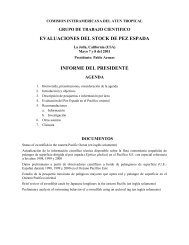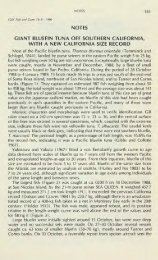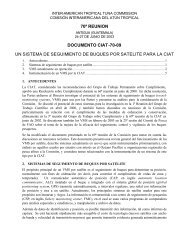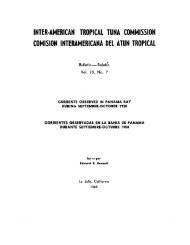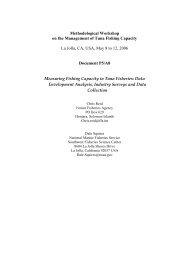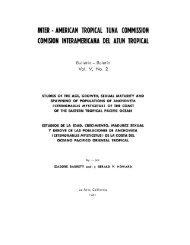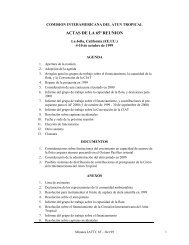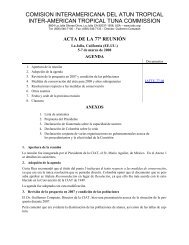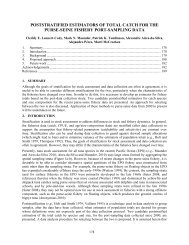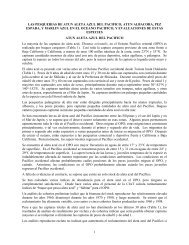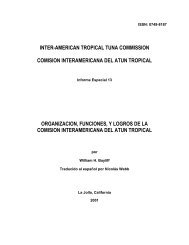Informe Anual de la Comisión Interamericana del Atún Tropical, 19
Informe Anual de la Comisión Interamericana del Atún Tropical, 19
Informe Anual de la Comisión Interamericana del Atún Tropical, 19
You also want an ePaper? Increase the reach of your titles
YUMPU automatically turns print PDFs into web optimized ePapers that Google loves.
ANNUAL REPORT <strong>19</strong>87<br />
set fishing, as it did during <strong>19</strong>73-<strong>19</strong>82, CPDF un<strong>de</strong>restimates yellowfin abundance, and when the<br />
fishery switches back to dolphin-set fishing, as it did during <strong>19</strong>84-<strong>19</strong>87, that CPDF overestimates the<br />
abundance.<br />
TUNABIOWGY<br />
Size composition ofthe cateh<br />
Length-frequency samples of yellowfin, skipjack, bluefin, bigeye, and b<strong>la</strong>ck skipjack,<br />
Euthynnus lineatus, from purse-seine and baitboat catches ma<strong>de</strong> in the eastern Pacific Ocean are<br />
collected by IATTC personnel at ports of <strong>la</strong>nding in Ecuador, Mexico, Panama, Peru, the USA<br />
(California and Puerto Rico), and Venezue<strong>la</strong>. The catches ofyellowfin and skipjack were first sampled<br />
by the IATTC staff in <strong>19</strong>54, and sampling has continued to the presento Information obtained from<br />
length-frequency samples has been used for the staffs estimates of growth, mortality, yield per<br />
recruit, and year-c<strong>la</strong>ss abundance. The results ofthese studies have been reported in several IATTC<br />
Bulletins and in all its Annual Reports since <strong>19</strong>54.<br />
The staff collected and processed 911 yeJlowfin, 359 skipjack, 15 bluefin, 13 bigeye, and 23<br />
b<strong>la</strong>ck skipjack samples from the <strong>19</strong>87 catches in the eastern Pacifico Most of these were 50-fish<br />
samples. For both yellowfin and skipjack, the length-frequency samples are stratified by market<br />
measurement areas (Figure 10), months, and gear. Sampling within each stratum is done in two<br />
stages, with a boat "unit" (usually a weJl or pair ofwells) as the first stage and individual fish as the<br />
second stage. The units within strata are sampled randomly and fish selected randomly from each<br />
sampled unit are individually measured. The total number offish in each length group in a sampled<br />
unit is estimated by dividing the total catch in weight in the unit by the average weight of the<br />
sampled fish in the unit and then multiplying this quotient by the fraction ofthe sampled fish in that<br />
length group. The stratum totals, in numbers offish, for each length group are obtained by summing<br />
the totals for each sampled unit and then multiplying this total by the ratio ofthe weight ofthe logged<br />
catch ofthe stratum to the sum ofweights ofthe sampled units. The quarterIy and annual totals are<br />
obtained by summing the data for all the sampled strata for the quarter or year in question. The<br />
quarterIy and annual average weights are obtained by summing over all the length groups in the<br />
quarterIy or annual estimates and dividing the sum into the sum ofthe weights of the catches for all<br />
the sampled strata.<br />
Histograms showing the estimated tons of yellowfin caught, by 2-cm intervals, based on<br />
logged catches, for the market measurement areas of the CYRA (Figure 10) in <strong>19</strong>87 are shown in<br />
Figure 11. The areas are arranged approximately from north (top) to south (bottom) in the figure.<br />
Most ofthe catch in Area 1consisted of fish less than 70 cm in length. In Area 8the fish in the catch<br />
ranged from about 40 to 140 cm. There were mo<strong>de</strong>s at 48,68, and 90 cm. In Area 2 most ofthe fish<br />
caught ranged between about 50 and 160 cm. In Area 4the fish in the catch ranged from about 40 to<br />
160 cm. There appear to have been several over<strong>la</strong>pping modal groups, with the most prominent<br />
centered at about 94-98 cm. There are indications ofmo<strong>de</strong>s at about 50,76, and126 cm. InArea 5the<br />
size range ofthe fish in the catch was about the same as in Area 4. There appear to have been several<br />
modal groups, the most prominent of which were at about 104 and 124 cm. In Area 6the size range<br />
was from about 30 to 150 cm. There are major mo<strong>de</strong>s at about 62 and 126-128 cm and severallesser<br />
mo<strong>de</strong>s. In Area 7 the fish caught ranged from about 40 to 160 cm. The catch in this area was low<br />
compared to those in most other areas, and there appear to be several mo<strong>de</strong>s, none of which is very<br />
prominent. Most ofthe fish caught in Area 13 were between about 120 and 150 cm in length. The most<br />
prominent mo<strong>de</strong> was centered at about 140 cm.<br />
Histograms showing the estimated tons of yellowfin caught, by 2-cm intervals, based on<br />
logged catches, in the entire CYRA for each year ofthe <strong>19</strong>82-<strong>19</strong>87 period are shown in Figure 12. The<br />
17



